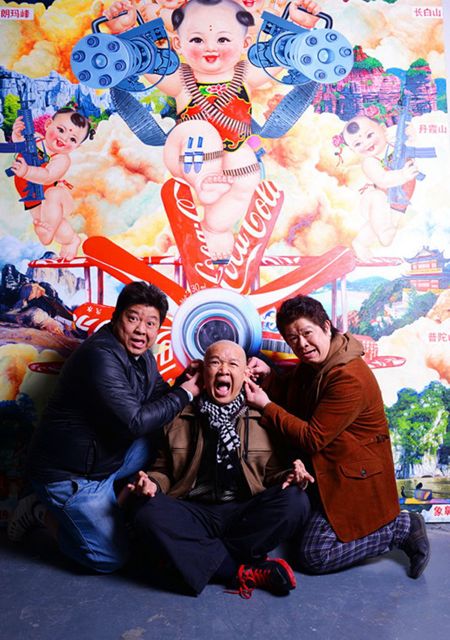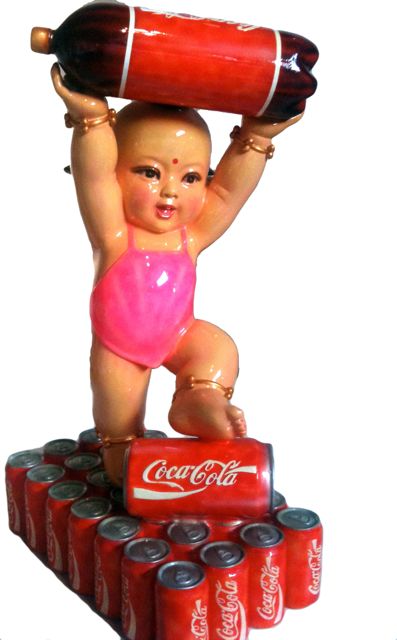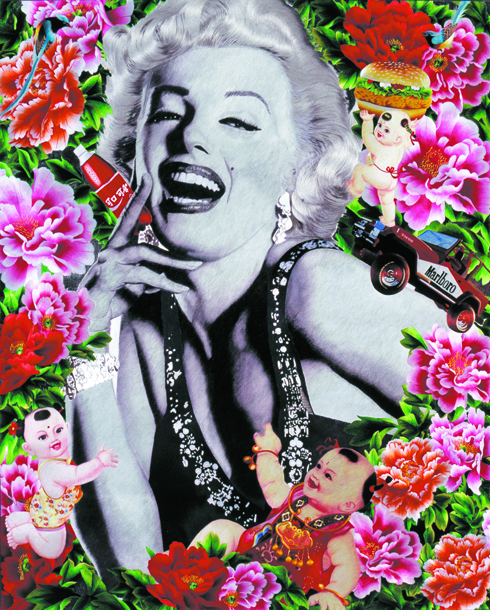The three Luo Brothers were born in Nanning, in the southern Chinese region of Guanxi Zhuang, in the period after the country’s Cultural Revolution. Each was given a name conjuring images of patriotism and strength.

Born in 1963, Luo Weidong’s name means ‘defender of the Orient’; Luo Weiguo, born in 1964, translates as ‘defender of the country’, and Luo Weibing, born in 1972, is ‘defender of the body’.
These names reflect the politics and nationalist ideas of the period, but by the time brothers had grown up and completed their schooling, China’s cultural climate had shifted.
Having each studied at different art academies, the brothers relocated to Beijing, where they continue to live and work today. Their collaborative work is symbolic of the changing society in which they live, drawing on China’s rich visual traditions along with its contemporary consumerism.

Two of the themes in the Chinese art world during the 1990s were ‘Cynical Realism’ and ‘Political Pop’, terms first coined by Li Xianting. Li Xianting had been enthusiastic and influential in introducing and advocating avant-garde art forms into the country, work that was often challenging and controversial.
During the 1990s, Cynical Realism and Political Pop rejected or subverted the collective mindset and concepts of the Cultural Revolution. Artists working in these genres often adopted post-ironic humour to tackle China’s changing socio-political landscape, as the country moved from Communism to modernization, industrialization and consumerism. The Luo Brothers have taken up these themes, creating pop art of a singularly eye-popping nature.
The brothers delve deep into China’s artistic heritage, both aesthetically and technically, employing the traditions of lacquer painting and ink-on-paper. They also produce sculptures that equally demonstrate an obsessive attention to detail and craftsmanship.

Whilst referencing the country’s past, the brothers employ carnivalesque psychedelic visuals to reflect the disorientating reality of China’s contemporary society.
Uniformly cheerful and plump cherubs ride goldfish laden with baskets of Heineken, brandishing bottles and burgers; towers of fizzy drink soar into the skies above the Forbidden Palace, whilst Chairman Mao gazes benevolently beneath the artificial orange glow of a Coca-Cola sun. Elsewhere, a giggling toddler dances upon a karaoke machine and Tiananmen Square is seemingly engulfed by flower blossom.

The Luo Brothers’ visual extravagance is often aesthetically satisfying, at other times almost nauseating.
In series such as Welcome to the Famous Brands of the World, the paintings’ surfaces are crammed with traditional symbols and icons, juxtaposed with popular brands such as Coca-Cola, Heineken, Pepsi, Oreo and Marlboro. These brands are ubiquitous, not only in China, but across the world, and in the brothers’ work have replaced the slogans and symbols of the Cultural Revolution.

On first appearances the brothers’ imagery is gaudily humorous, but on further inspection the symbolism at play is fairly hard to define. Are they mocking the new consumerism and the emptiness of modernization, or are the leaders and concepts of the Communist era the subjects of their ridicule? And does their acid-bright pop imagery aim to reflect the horror of a multi-coloured consumerist world, or positively celebrate and revel in it?
Perhaps they are stating that materialism has replaced idealism, for good or for bad.
